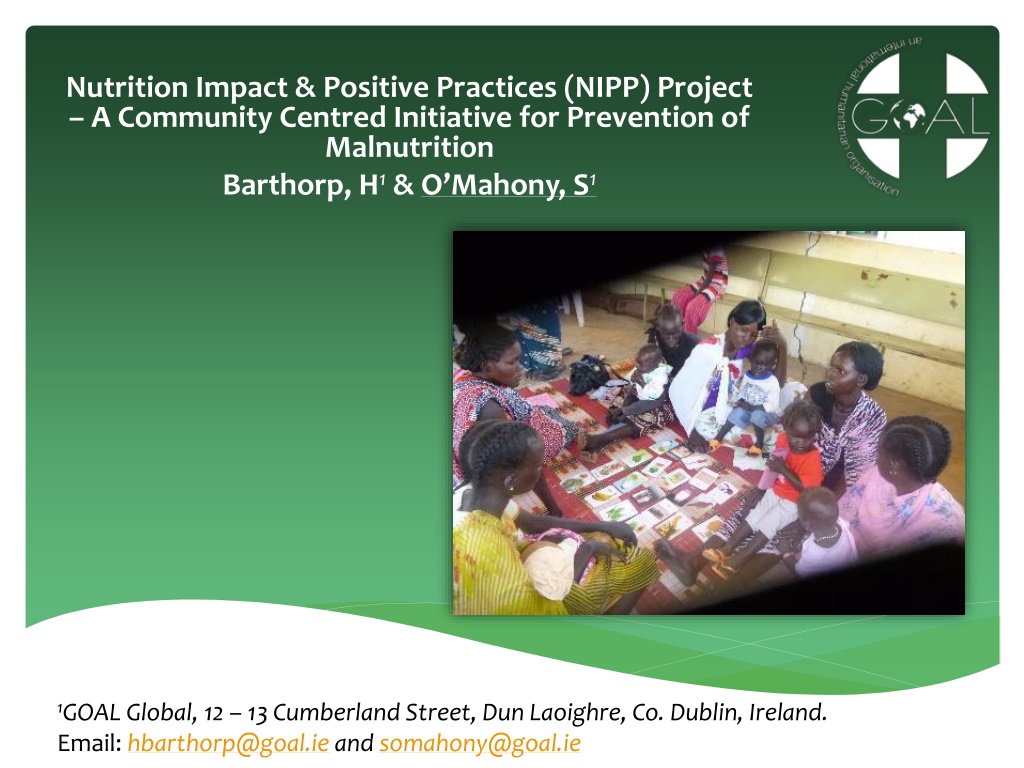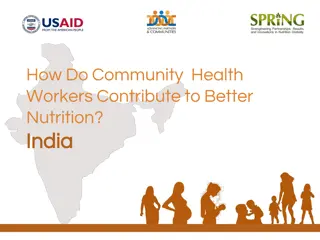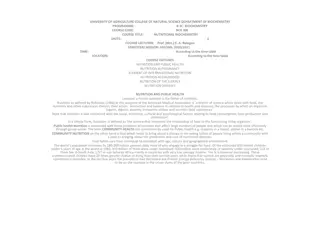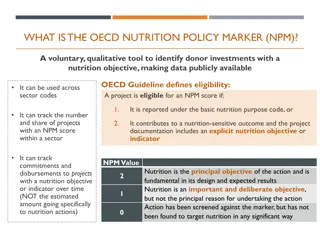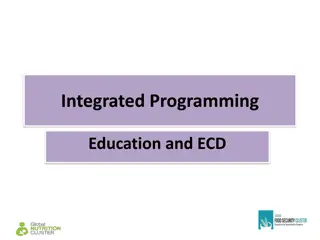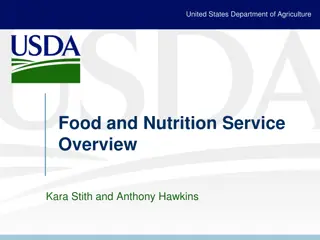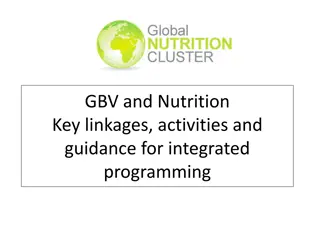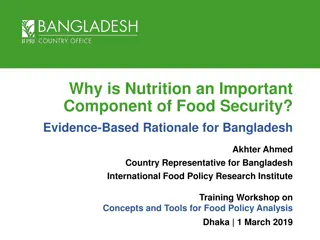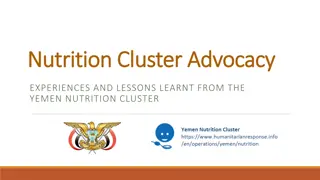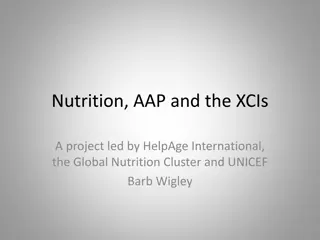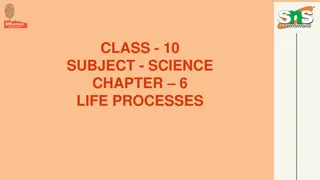Nutrition Impact & Positive Practices (NIPP) Project Overview
The Nutrition Impact & Positive Practices (NIPP) Project is a community-centered initiative aimed at preventing malnutrition, particularly focusing on women, infants, and young children. GOAL Global designed this project to reduce rates of acute and chronic malnutrition through behavior change interventions. With a grassroots approach, NIPP has been implemented globally, reaching over 11,000 beneficiaries and achieving successes in improving nutritional status and household practices. The project's rationale lies in addressing behavioral causes of malnutrition and utilizing locally available resources for sustainable impact.
Download Presentation

Please find below an Image/Link to download the presentation.
The content on the website is provided AS IS for your information and personal use only. It may not be sold, licensed, or shared on other websites without obtaining consent from the author. Download presentation by click this link. If you encounter any issues during the download, it is possible that the publisher has removed the file from their server.
E N D
Presentation Transcript
Nutrition Impact & Positive Practices (NIPP) Project A Community Centred Initiative for Prevention of Malnutrition Barthorp, H1& O Mahony, S1 1GOAL Global, 12 13 Cumberland Street, Dun Laoighre, Co. Dublin, Ireland. Email: hbarthorp@goal.ie and somahony@goal.ie
Presentation Overview 1. Aim and Objectives of NIPP 2. Rational for Developing NIPP 3. Overview of NIPP Implementation Globally 4. Overview of NIPP Approach 5. Global NIPP Statistics 6. Successes in NIPP to Date 7. Conclusion
Aims and Objectives of NIPP GOAL: GOAL: To reduce rates of acute malnutrition (MN) and/or chronic malnutrition in target communities with a focus on women, infants & young children + other at risk groups. Specific Specific Objectives or Outcomes: Objectives or Outcomes: Through positive and sustained behaviour change we aim to: 1. Improve the nutritional status of targeted individuals with confirmed MN 2. Improve families understanding of why MN occurs in high risk individuals & what can be done to prevent future episodes 3. To improve household (HH) diet diversity (and thus nutritional repleteness) of targeted HHs 4. To achieve sustainable improvements in HH care practices (including hygiene-sanitation), feeding practices and health-seeking behaviours for infants, children, pregnant or lactating women (PLW) & the chronically ill (CI), through the promotion of positive behaviour change
Rational for Developing NIPP It is estimated globally 33 million children suffer from moderate acute malnutrition (MAM, WHZ<-2 and -3) (UNICEF et al 2012) and 171 million children suffer from chronic malnutrition (HAZ <-2) (WHO, 2010) GOAL designed the Nutrition Impact and Positive Practices (NIPP) project as a gendered, grass-roots approach, directly tackling a package of the underlying behavioural causes of malnutrition, irrespective of the particular manifestations Although the original stimulus for designing NIPP was to find an alternative to food-based aid programs, the way in which NIPP is designed does not restrict its application to areas affected by acute malnutrition Designed as a low cost intervention that helps the communities to use locally available resources.
Overview of NIPP Globally NIPP Globally: GOAL innovation started in 2012 in South Sudan Now implemented in 5 countries across Africa To date has reached over 11,000 direct beneficiaries NIPP has successfully cured 2148 (81.64% cure rate) children 6 59 months of moderate acute malnutrition.
Overview of NIPP Approach Diagram of Key Components to help illustrate the initiative as a whole Designed to Address: Community based TREATMENT of mild or moderate acute MN (MAM) Community based PREVENTION of mild or moderate acute MN (MAM) Potential community based REHABILLITATION & PREVENTION of STUNTING Potential community based PREVENTION of LBW (due to inter-uterine growth restriction) FORMATIVE RESEARCH: Situational & Barrier Analyses COMMUNITY SENSITISATION CIRCLE MENS PEER LED NIPP CIRCLE WOMENS PEER LED NIPP CIRCLE Incorporate the following initiatives if they are lacking from community HHs: Fabrication & use of a simple hand-washing point i.e. Tip- Tap with ash or soap Fabrication of & use of simple latrines using local materials only Fabrication & use of fuel efficient stoves Practical demo s on food processing, preservation & storage techniques. Practical Behaviour Change Sessions focused on key causes of undernutrition: To reinforce positive behaviours through practical sessions. Key Health, WASH, HIV, Nutrition & LLH messages should be discussed & practiced during the sessions Participatory Cooking Demonstrations: To help improve nutritional status & care practices All ingredients to be provided by participants and eaten by children >6mths & PLW / CI as a complementary or supplementary meal Micro-gardening: To improve household nutrition security OVERALL AIM IS: POSITIVE & SUSTAINED BEHAVIOUR CHANGE Remember it doesn t matter how many Circles are running or what project coverage you have, if positive and sustained behaviour changes are not being achieved, the project (as it is) is not succeeding & needs reviewing
NIPP Outcomes Globally House Hold Diet Diversity on Admission and after Graduation from NIPP NIPP Beneficiary % Cured By Country Children 6 - 59 months and PLWs 100 100% 95.79 94.54 91.11 88.89 90 90% 81.64 80% 80 70% 70 65.38 63.63 61.97 58.68 60% 60 56.25 53.84 50.00 50% 50 40% 40 30% 30 20% 20 10% 10 0% 0 Malawi Niger Sudan South Sudan Zimbabwe Total Malawi Niger Sudan South Sudan Zimbabwe Total % Achieving minimum diet diversity on graduation % Cured 6-59 Months % Achieving minimum diet diversity on admission
NIPP Longitudinal Follow Up % children aged 6 - 59 months with MUAC > 11.5 < 12.5 cm 50.00% 45.00% 40.00% 35.00% 30.00% 25.00% 20.00% 15.00% 10.00% 5.00% 0.00% Admission Graduation 2 Months 6 Months 12 Months
NIPP Longitudinal Follow Up % HH with an established micro garden 12 Months 6 Months 2 Months Graduation Admission 0.00% 10.00% 20.00% 30.00% 40.00% 50.00% 60.00% 70.00% 80.00% 90.00% 100.00%
NIPP Longitudinal Follow Up Diet Diversity: % of 6-23 mnths HH who ate 4 or more food groups 80.00% 70.00% 60.00% 50.00% 40.00% 30.00% 20.00% 10.00% 0.00% Admission Graduation 2 Months 6 Months 12 Months
Successes in NIPP to Date NIPP has been nominated for a prestigious award from the UN s Common Humanitarian Fund in Sudan Incorporated in the Sudan MoH Guideline for the Management of MAM Recognised by UNOCHA as an innovative project to tackle malnutrition in South Sudan Presented at CORE GROUP Q2 2014 NIPP has been published on in Field Exchange Edn 47 & Nut. Exh 3 Publications in the Sudan Medical Journal. Featured in the technical resource guide: Enhancing Nutrition and Food Security during the First 1,000 Days through Gender-sensitive Social and Behavior Change Recently complete qualitative research into programme design.
Conclusion Countries affected by high rates of malnutrition require alternative or complimentary solutions to therapeutic hand-outs. A combination of practical, contextually specific nutrition information, accompanied by practical nutrition sensitive activities, can be effective in managing MAM and potentially chronic malnutrition, in areas with underlying basic food security.
Thank you! Questions?
